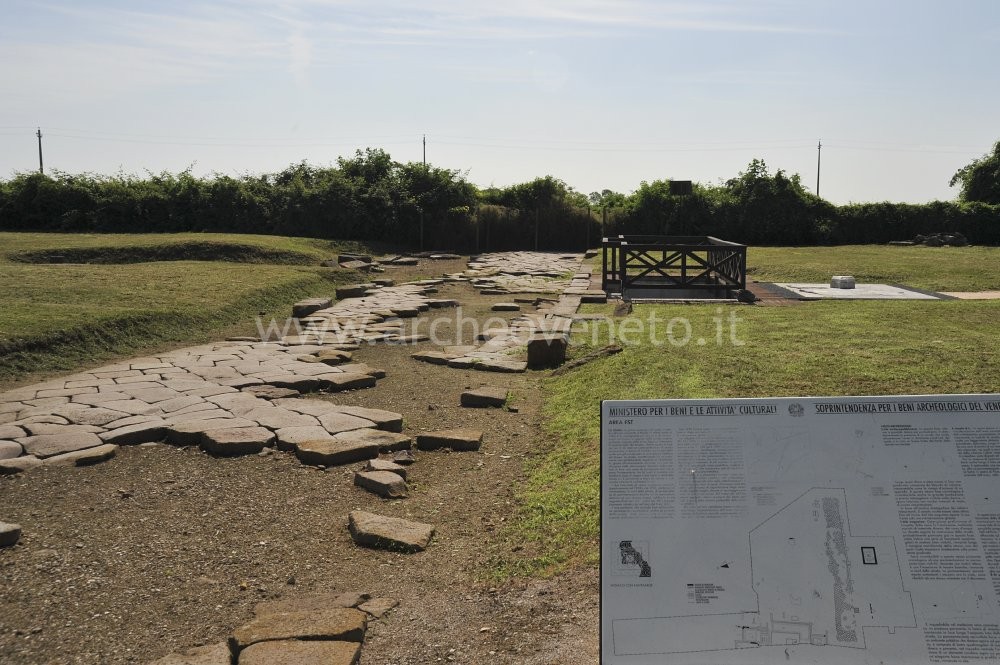|
|
File
Roman road and houses in the area east to the Museum – Quarto d’Altino
|
Via San Eliodoro 37 (National Archaeological Museum) – 30020 Quarto d’Altino (VE)
– Fax 0422 829008 |
  |
|
Summary

The archaeological area on the eastern side of the Museum of Altino displays the remains of a river landing place, of a road and of some houses of the Roman Altino.
History of research
Following the discovery of Roman artefacts during ploughing activities, the excavations that were carried out in 1962, 1963 and 1965 uncovered the road and the domus. Further excavations in 1984 and between 1988 and 1990 allowed to broaden the researches on the domus, to identify the remains of a river embankment and to find protohistoric artefacts.
Urban and geographical context
Altino is a hamlet of “Quarto di Altino” and is located in the plain, in the same place as the homonym Roman city that was once on the Veneto lagoon. The territory is crossed by the final part of the river Sile, which splits at the hamlet of Portegrandi and whose main branch continues towards Jesolo along the channel that was excavated by the Venetians at the times of the Serenissima (the so-called “Taglio”). The archaeological area is located in the territory of the village “Quarto d’Altino” and it used to be close to the north-central border of the Roman settlement.
Chronology
I B.C. – IV A.D. |

 In late Republic times the area which we visit today was crossed by a north-south oriented channel, the Sioncello, which probably linked the city of Altino to the Veneto lagoon. In this place the channel was accessible through stairs made in blocks of sandstone, which are still visible today within the wooden fence. In late Republic times the area which we visit today was crossed by a north-south oriented channel, the Sioncello, which probably linked the city of Altino to the Veneto lagoon. In this place the channel was accessible through stairs made in blocks of sandstone, which are still visible today within the wooden fence.
The channel was filled in Augustan times and the whole area underwent a full renovation. Above the channel a road (A) was constructed, which was paved in slabs of trachyte and which has been interpreted as one of the east-west oriented roads (“decumanus”) of the city. The road had porches on its southern side, as it is documented by the bases plinths of the porch that are visible today. A house was also built, in line with the “decumanus” and with clay floors which are now covered by later pavements. To this same time we date the remains of the pavement of squared marble slabs (B), with a central element bearing an elegant round marble basis on top. This pavement pertained to a public building that would be accessible from the porch and whose function is still unknown.
The road was entirely re-built in the II century A.D. with a slightly different orientation. Just as before, the road is flanked by a building with a porch whose bases plinths still remain visible. In this same time the domus (C) is also renovated, that contains the most numerous and best preserved mosaic pavements in the whole archaeological area. The domus was north-south oriented and was organized around a central uncovered atrium (courtyard) with Prun stone pavements and porches on all sides. The entrance was located on the main road and was on the same axis as the courtyard and the “tablinum”, the mosaic paved house office on the north side of the atrium. The other rooms on the north and east sides of the atrium have uncertain function. Some traces of a second house on the north side of the road still remain, and particularly a valuable mosaic pavement made of pieces of glass covered with gold and drawing a central decoration in the shape of a “kantharos” (a type of drinking pottery with high swung handles which extend above the lip of the pot).
To the late antiquity we date the foundations of a massive building on the north of the domus (D), which has been interpreted as a public building with uncertain function.
|

Admission: Negli orari di apertura
Visitability: Esterno e Interno
Ticket: Si
Price: Full price ticket: 3 euro; reduced price ticket: 1,5 euro. The ticket is valid for visiting the sites and the National Archaeological Museum of Altino.
 School access School access
Preferably upon reservation
Opening Days
| Tipology |
When |
Specs |
| Mon-Sun |
8.30-19.30 |
|
Closed on Christmas, New Years’ Eve, I May. The ticket office closes at 7pm.
Recommended tour time (minutes): 40
 Toilet Toilet
Toilets of the Museum
 Parking Parking
Parking of the Museum
 Guide a stampa Guide a stampa
Audio guide
 Information boards Information boards
 Multilingual ads: Inglese Multilingual ads: Inglese
Tedesco
Panels
 Guided Tours Guided Tours
Guided tours by the agency "Synthesis", tel. 041 5311460 / 5310368, e-mail: synthesis@tin.it
 Educational activities Educational activities
Teaching activities by the agency "Synthesis", tel. 041 5311460 / 5310368, e-mail: synthesis@tin.it and by the association "Studio D", tel. 049 8360553, e-mail: info@studiodarcheologia.it
 Educational workshops Educational workshops
Association "Studio D", tel. 049 8360553, e-mail: info@studiodarcheologia.it
 Library and documentation centre Library and documentation centre
| Fogolari G. 1964, Altino (Venezia). Strada romana ed ambienti con mosaico, in Bollettino d’Arte, XLIX, 4, pp. 397-398. |
| Mangani E., Rebecchi F., Strazzulla M.J. 1981, Emilia, Venezie (Guide Archeologiche Laterza), Bari, pp. 193. |
| Tombolani M. 1987, Altino, in Il Veneto nell’età romana, II, a cura di Cavalieri Manasse G., Verona, pp. 332-335. |
| Tirelli M. 1993, Il Museo Archeologico Nazionale e le aree archeologiche di Altino, Padova, pp. 29-36. |
| Tirelli M. 2003, Altino, in Luoghi e tradizioni d’Italia. Veneto, I, Roma, pp. 32-45. |
| I luoghi della cultura 2006, Roma, pp. 376. |
| Bonetto J. 2009, Veneto (Archeologia delle Regioni d’Italia), Roma, pp. 499-500. |
|

